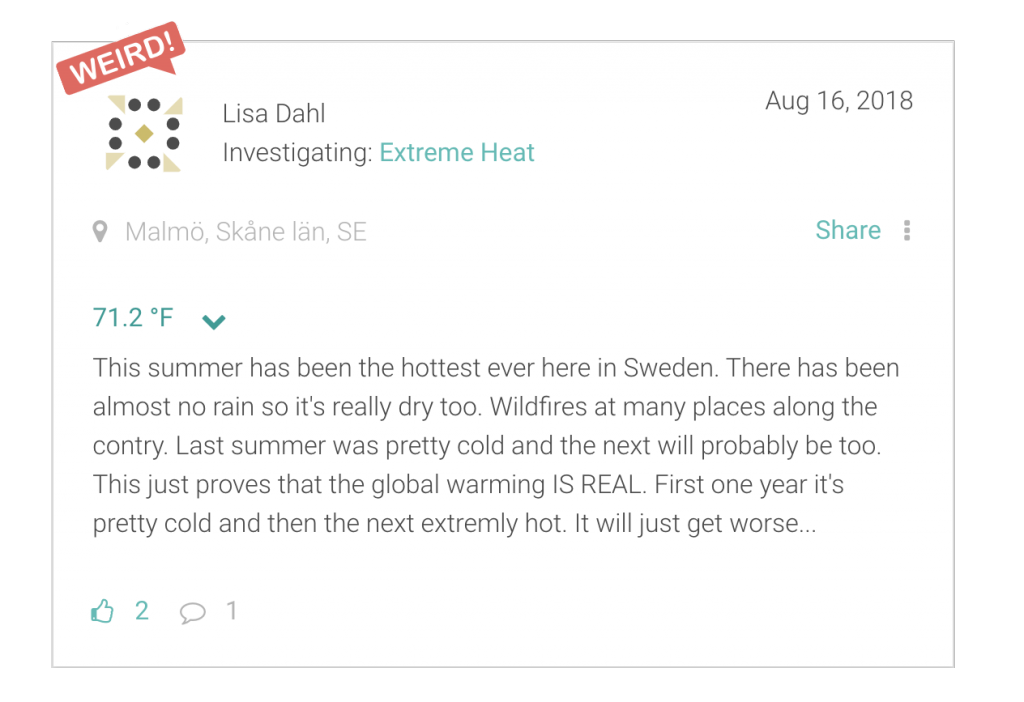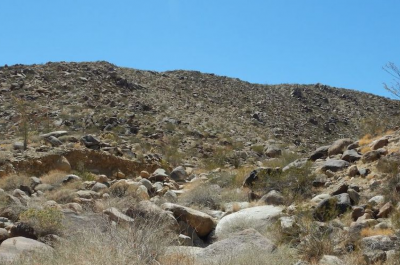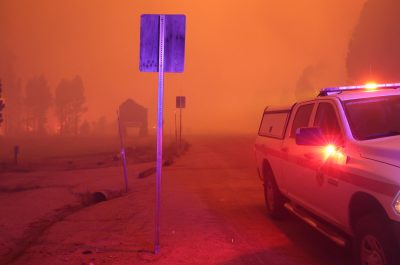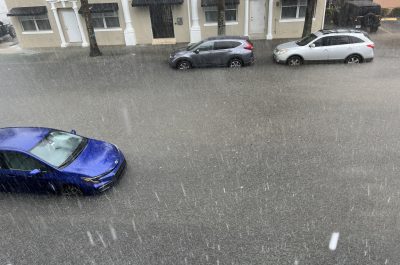In many ways ISeeChange in 2018 was either a story of precipitation or lack thereof. Floods, hurricanes, droughts and wildfires impacted communities across the globe.
In the U.S., ISeeChangers revealed a widening gap between east and west. In the winter, western states were warm and dry, while east of the Rockies, the winter was cold and wet. Both of these trends had far-reaching impacts on daily life that played out throughout the year.
Worldwide, 2018 was another year of rising temperatures, increasingly deadly and expensive natural disasters, and for the second year — after a two-year break from 2014-2016 –global emissions rose again.
Our community of users documented unusual precipitation patterns, extreme heat, and flooding from the U.S. to Kenya to India. We see and hear climate change impacts through your eyes. When you tell us that “you’ve never seen” something before, when you use the word “unprecedented,” or something just seems “weird” – we pay close attention.
Last year was the fourth warmest year on record, while the past four years consecutively – 2015, 2016, 2017 and 2018, make up the top four warmest years ever. And 20 years out of the last 22, comprise the warmest in the history of record-keeping. The trend is evident: our world is changing rapidly.
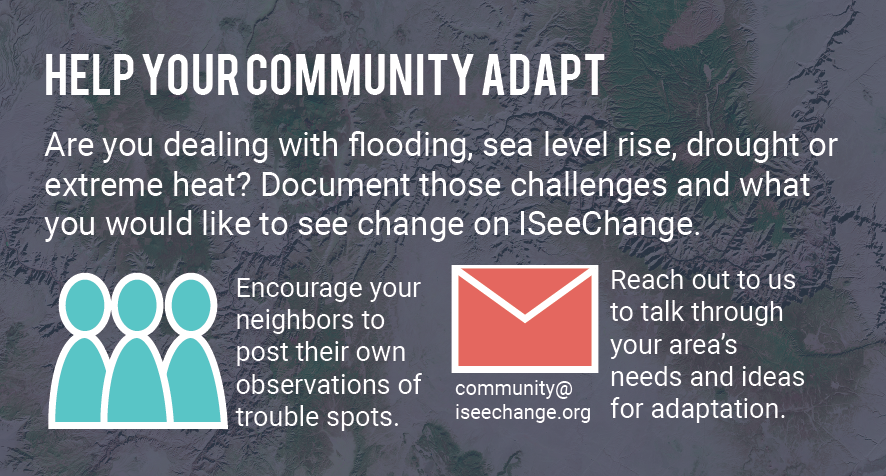
Since 2012 ISeeChangers have documented those changes in their backyards. As weather continues to become more extreme, we’ve seen the need for community adaptation solutions. As a result, ISeeChange expanded our work in flood-prone communities and in urban heat monitoring in 2018. We added new features to allow ISeeChangers to collect data alongside their stories to inform resilience planning. This will continue throughout 2019 with sea level rise and drought, and if you want your community to get involved, please reach out.
But first — here’s a rundown of what we saw through your eyes in 2018. As you read through the posts from last year, reflect with us. How does your today compare to last year? Have you been reporting the same phenomena and seeing patterns? Did we miss anything? You can post anything on ISeeChange.org from anytime, just change the date if you need to. Every post counts to tell the bigger picture stories from your back yard- season to season, year to year.
In the U.S. low western snowpack sets the stage for fire and more
From California, to Colorado, ISeeChangers reported warm temperatures and a snow shortage throughout the winter months last year.
“I’ve been waiting for Winter in CO all ‘winter,’” said one of our longtime observers, Andrea Lecos, in Paonia, Colorado in February. “It’s unprecedented to not even wear a coat or gloves or hat between Nov and March in Colorado, but that is the case this year. I’ve been hiking instead of skiing! Pollen is coming on already with Junipers. It got up to 65 degrees. What little moisture we’ve had the past few months has been in the form of rain- rain! I’m very concerned about water shortages and fires this summer, and bees and other animals not having food. Is this the beginning of our future?”
Reports echoing her sightings came from ISeeChangers in New Mexico and Arizona. “Working on a 100 year record for ‘days without rain or snow,’” said another long-time ISeeChanger Peter Callen in Placitas, NM. “I’ve never seen the mountain tops without snow in the winter, but here we are in January and the mountain tops of Northern New Mexico are rocky and bare.”
This exceedingly dry winter and the lack of precipitation that continued into the summer set the stage for dry rivers, stressed trees, thirsty pollinators, dry crops and pastures which caused economic woes for farmers and ranchers.
The drought also paved the way for devastating wildfires.
Those wildfires created poor air quality that extended across the country and caused health concerns for nearby communities. “I stay inside with windows closed if the air is too smoky because it makes my eyes hurt and one incident was bad enough to make breathing difficult,” said Sue Stroud to the north in Brentwood Bay, British Columbia.
Related ISeeChange stories: When the river runs dry, 416 Fire makes Coloradans wonder if wildfires have limits, How will plants and their pollinators face a warmer world, and Searching for the city trees of the future in Southern California.
Winter thermometer seesaw
ISeeChangers along the East Coast and in the Midwest reported extreme temperature swings from January to April, making winter inconsistent and unpredictable
“I have experienced New York winters before, but this more recent had been strange,” Richard Pankratov posted in February. “The weather patterns have been a mixture of everything imaginable, and some not. Days have varied from below freezing, to very warm, near T-shirt weather.”
In Vermont, the frequent freezing and thawing led to damaged infrastructure according to this ISeeChanger, alongside reports of an “early pothole season” by transportation authorities The warmups also confused plants and wildlife. In upstate New York, one observer noted robins returning early while in Wisconsin, sandhill cranes did the same, as did hummingbirds in North Carolina.
Birds and plants were made extra confused by an onslaught of spring snowstorms amidst the warming. In the Northeast, a series of record-breaking March nor’easters brought heavy winds and wet snow that damaged trees and power lines, caused coastal flooding, black ice, and cancelled schools.
In the Midwest, migratory birds returning too early were left out in the cold.
As the snow melted, rivers and streams filled and flooded giving a damp start to what would turn out to be an unusually wet year.
Related ISeeChange stories: How a warming Arctic may be driving snowstorms and cold on the East Coast and Is climate change to blame for a whack spring?
Wet springs and falls from the Midwest to the Northeast and Gulf
Snowmelt from those spring storms combined with spring rain led to flash flooding in parts of the East Coast and the South in April. Meanwhile risk of river flooding rose in those areas as well as the Midwest.
While New England and the Midwest dried out a little in May and June, the Southeast got soggy and a major rainstorm hit ISeeChangers in New Orleans on May 18 covering streets in water and blowing festival tents around.
New Orleans then passed much of the summer without a major rain event— which was very different than 2017. To the north, the Mid-Atlantic, Northeast and Midwest were waterlogged again by July and lakes and rivers that been high in the spring swelled to their banks again in August.
All that water damaged some late-summer and fall crops. “At least we don’t need to worry about wells running dry, but the garden is looking a bit sad,” said Judy Donnelly, a long time ISeeChange observer in Connecticut. “Too much rain and muggy weather leads to fungus on the tomatoes.”
After a relatively dry summer, rain and warmth swamped the Gulf South in the late fall and winter. The grey days made residents feel as though they were living in the a different region entirely
“I feel like I haven’t seen the sun in a week,” said Destiney Bell in New Orleans, “It’s very dreary weather, which I can only imagine is having negative effects on people’s mental health (it certainly is affecting mine).”
More flooding at Hunter’s Field playground. The conditions are exacerbated by runoff from I-10.
Rain wasn’t the only thing that caused flooding. In early 2018 researchers reported that melting ice sheets have been responsible for seven centimeters of sea level rise since 1993. They projected that rate could triple by 2100. Coastal communities are already feeling the impact of rising seas. In October and November, new ISeeChange observers from coastal communities in the east like Hampton, New Hampshire, Virginia Beach, Virginia, and Ocean City, New Jersey reported tidal flooding events.
Related ISeeChange stories: Summer storms reveal that New Orleans has more than just a pump problem and The race to slow stormwater and predict future rain.
Ocean weirdness
ISeeChangers also reported another impact of rising seas, coastal erosion.
The ocean warmed to record-breaking levels again in 2018 and scientists reported that the seas have been warming even faster than predicted by the UN in 2013. These warm waters fueled destructive hurricanes that impacted ISeeChangers on both the Pacific and Atlantic Oceans.
Warming waters also impacted ISeeChangers in Sarasota, Florida who dealt with a months-long algae bloom called Red Tide that killed marine life, caused respiratory illness and damaged the town’s tourism with the stench of fish rotting on the beaches. Heavy rains from Hurricane Irma in 2017 and from spring rainstorms in Florida contributed to the bloom by producing nutrient-rich runoff.
Other strange things
ISeeChangers in a variety of locations also noted two potential emerging trends: more algae blooms on lakes, and plants blooming in the fall when they typically bloom in the spring.
ISeeChangers reported algae blooms on lakes in California, Ontario and Wisconsin in 2018. Even on Lake Superior, a traditionally cold and low-nutrient lake, there was an unprecedented algae bloom this summer. Algae thrives in warm, nutrient-rich water so the combination of rising global temperatures with increasingly intense storms that cause runoff may make algae thrive. If you see any in your area in 2019, be sure to share it in an observation. We’ll be reporting more on this soon.
Fall blooming was another weird trend that we saw documented by several ISeeChange observers in the Northeast. In Rhode Island, one observer found their lilac — a spring bloomer — blooming in early-October. In New Jersey, this rhododendron — another spring bloomer — bloomed in mid-November. While apples — yet another spring bloomer — bloomed in upstate New York in October.
If you saw anything like this in 2018, you can back-post at any time, and be sure to keep an eye out for plants that seem to be blooming at off-times in 2019- especially in the winter!
Worldwide weirdness
Beyond North America, 2018 saw plenty of weird weather and climate trends across the globe. ISeeChange is lucky to have a small-but-growing community of international users who give us a peek into what climate change is like around the world. We are always looking to increase global perspectives on ISeeChange, so tell your international friends to sign up and share!
South and Central America: precipitation problems
In parts of South and Central America, punishing droughts that spurred migration and devastated crops leaving many hungry. In Brazil, one ISeeChange observer noted that storms seemed to be getting stronger and windier.
Europe: cold spring, hot summer, record-breaking natural disasters
Moving west, observers in the UK and Russia reported colder-than-normal spring temperatures. Europe followed that cool spring up with a blazing-hot summer full of wildfire.
In the fall, as in the U.S., countries in central Europe and the north Mediterranean received powerful rainstorms that led to flooding. In December, an Italian ISeeChanger noted that plants that should have gone dormant were still green.
Africa: Precipitation and pests mess with crops and daily life in Kenya and Cameroon
Long time ISeeChanger Kamweti Mutu has been documenting changing precipitation patterns in his neighborhood outside Nairobi, Kenya for several years. After a relatively-dry 2017, Mutu noticed that 2018 started out wetter than usual.
By May, Kenya was dealing with deadly floods that displaced people and devastated crop and livestock farmers. Precipitation patterns in Mutu’s area continued to be strange with steady rain in the early-fall dry season. The typical “short rains season” in November saw lower-than-normal rainfall but then picked up late, dumping rain in December.
West of Mutu, in Cameroon, an ISeeChange observer reported unpredictable precipitation and insects on maize crops that he worried would hurt crop yields. Rainfall weirdness ultimately didn’t leave a major mark on crop production in Cameroon, though civil unrest did. Meanwhile, one pest native to the Americas, the fall armyworm, is a growing problem in Cameroon. In the past two years the fall armyworm has infected “80,000 hectares of farmland in Cameroon, slashing harvests of the country’s staple cereal crops by as much as three-quarters in some regions,” according to a Reuters report.
Asia: Observers in India deal with extreme heat
ISeeChangers in India reported warmer-than-usual temperatures from January to May. In Pakistan, a heat wave during Ramadan in May killed up to 100 people. One observer in northern India, in the city of Kharakhet, noticed that rainstorms that she’d usually expect to see in March started in February instead.
In May, neighboring state Uttar Pradesh was hit with a dust storm that killed over 100 people. Then, the southern state of Kerala experienced deadly, record-breaking flooding in June.
The wet trend in the country continued into December when one ISeeChanger, Eklavya Tyagi observed an unusual hailstorm, “Which ‘til now has never happened in the month of December due to lack of moisture.”
ISeeChangers in India also grappled with poor air quality and pollution throughout the year. “There has also been increasing concern among the citizens about the government prioritizing development over the environment,” said observer Abhramika Choudhuri in Pune, a city about two hours from Mumbai.
Related ISeeChange stories: Floods and drought force Kenyans to cope with climate change
Looking to 2019
Throughout 2019 we will continue to study your posts to identify what climate issues and impacts people across the world are dealing with. Often ISeeChangers are noticing important trends long before scientists, governments, and mainstream media.The ISeeChange team is busy developing new features for our community to see those changes and track them.
And our community is already documenting winter weirdness to watch.
Keep us posted on what’s happening in your backyard and how it’s impacting you! Every sighting counts.
Story by Samantha Harrington
Cover art by the U.S. Army Corps of Engineers.


